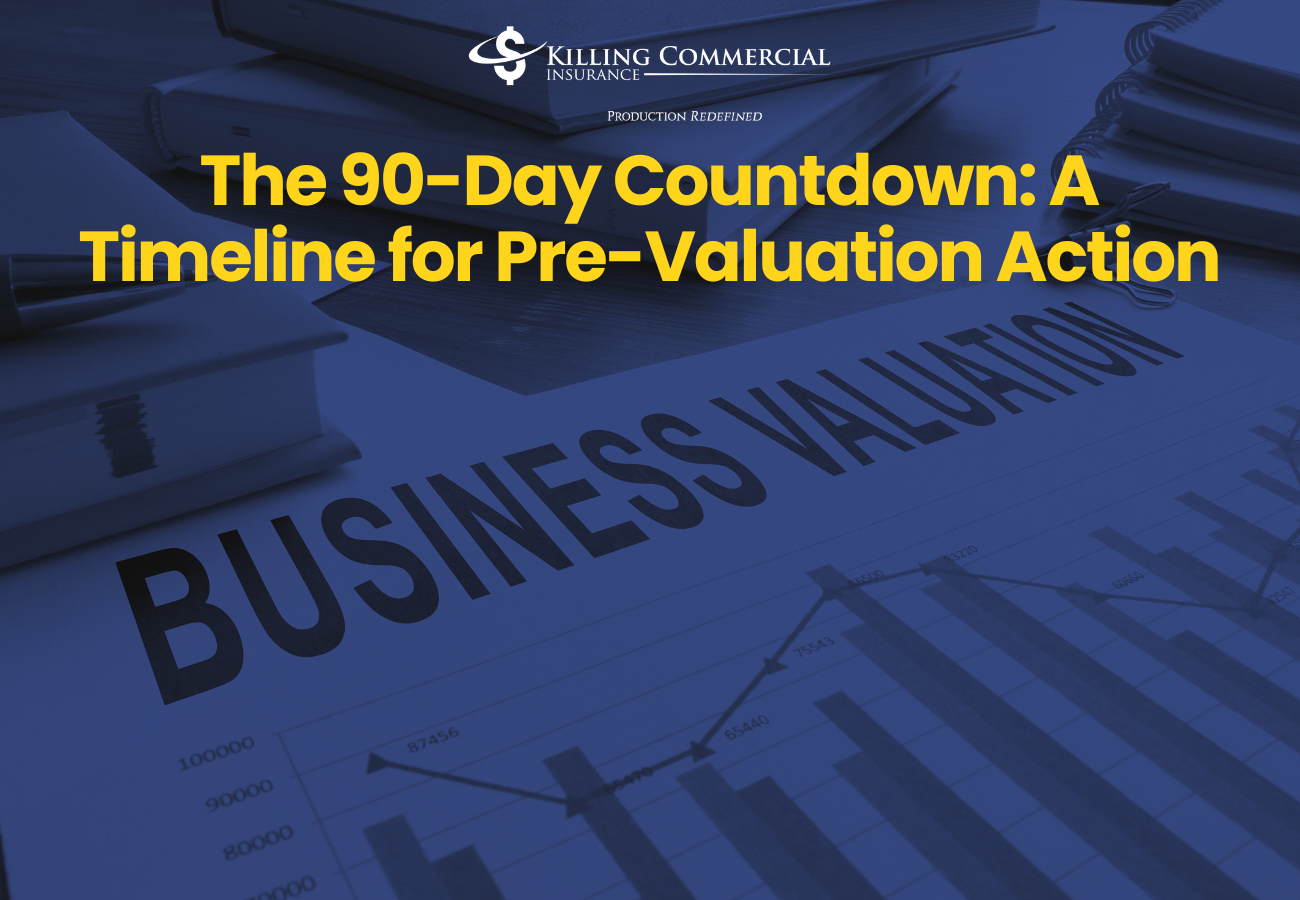Mastering the Experience Mod: How Proactive Claims Management Before the Valuation Date Saves Clients Money – A Conversation with Kevin Ring

In the world of commercial insurance, few tools are as misunderstood—or as underutilized—as the valuation date in a workers’ compensation policy. Yet understanding this single date can unlock a world of opportunity for proactive producers to both protect their clients and drive significant revenue for their agencies.
When you lead with workers’ compensation and position yourself as an expert on the experience modification rating (mod), you’re not just selling a policy—you’re managing a dynamic risk factor that can impact pricing for years. In this 2nd blog post of Kevin Ring, we’ll explore how producers can take control of this process, improve client outcomes, and stand apart from competitors by owning the mod through better claims advocacy.
Understanding the Importance of the Valuation Date in Workers’ Compensation
What Is a Valuation Date?
The valuation date, also referred to as the unit stat date, is the moment when an insurance carrier sends critical data to the rating bureau that calculates your client’s experience modification factor. Historically, this data was submitted via paper forms known as unit stat cards, but today, it’s all handled electronically.
Technically speaking, the valuation date occurs 18 months after policy inception, regardless of cancellation or policy changes. It continues to be reported annually for up to ten years if claims remain open. However, the first three valuation submissions are what matter most—they directly influence your client’s experience mod rating, which determines their future premiums.
Why the Valuation Date Is a Producer’s Secret Weapon
The valuation date is when the carrier captures a “snapshot” of the account—payrolls, class codes, and most critically, open claims reserves. These reserves, representing projected but unpaid amounts, are treated the same as actual paid losses when calculating the mod.
Imagine a claim with $1 paid and $99,999 in reserves. That claim impacts the mod the same as a fully paid $100,000 claim. That’s why the reserves on open claims, when overstated, can artificially inflate your client’s premium—unless you intervene beforehand.
Identifying Open Claims and Analyzing Loss Runs
How to Read Loss Runs Effectively
Loss runs are your window into the carrier’s claims data. To influence the mod, producers must review currently valued loss runs 90–120 days before the valuation date.
Start by identifying open claims—look for the status indicator or check for any value in the reserve columns. By definition, a closed claim will have all zeros in reserve fields. Even if a claim is technically “resolved,” if the reserve remains, it will still impact the experience mod.
Unfortunately, not all loss runs are created equal. Inconsistent formatting and incomplete fields are common. Still, it’s your responsibility as the producer to get familiar with your client’s claims data and act on it.
Why Open Claims Matter More Than Closed Ones
While closed claims are “baked into the cake,” open claims are still malleable—particularly their reserves. Producers often overlook this opportunity, assuming that they can’t change anything. But the opposite is true: timely claims advocacy before the valuation date can significantly reduce reserves or even close claims entirely.
This can yield a double win: lower experience mod and reduced future premiums—without sacrificing the client’s ability to receive appropriate care or benefits.
The 90-Day Countdown: A Timeline for Pre-Valuation Action

Step 1 – Request Current Loss Runs
Begin the process 90 to 120 days ahead of the valuation date. It’s not that this will require three months of work—but it often takes that long to gather the information you need, have the right conversations, and coordinate with clients and adjusters.
Identify which claims are still open, and start creating your game plan. Prioritize higher-reserve claims or those where there’s new information that hasn’t yet been communicated to the carrier.
Step 2 – Contact the Claims Adjuster
Approach this step with humility and collaboration, not confrontation.
Your script is simple:
“I’m preparing for a meeting with my client and wanted to check in on the status of these open claims. Can you walk me through the current status and any anticipated next steps?”
This positions you as a helpful partner. Adjusters are overworked and under pressure, and most aren’t eager to take calls from accusatory agents. By coming from a place of cooperation, you’re far more likely to get the information you need.
If the adjuster can follow up with an email summary or written confirmation of next steps—especially if they agree to reduce reserves—get that in writing. This is your insurance policy in case changes don’t show up in the updated loss runs.
Step 3 – Verify Status with the Employer
Next, compare what the adjuster says with what the employer knows. Oftentimes, there’s a disconnect.
The adjuster might say an employee is still off work pending evaluation, but the employer may have seen them return to light duty last week. That discrepancy matters.
Encourage the employer to obtain or share documentation—a work release note, updated treatment plan, or clearance from a physician. This helps fill in the gaps for the adjuster and expedites claim closure or reserve reduction.
Step 4 – Follow Up and Confirm Adjuster Action
As the valuation date approaches, request updated loss runs to verify that agreed-upon changes were made. If not, your written confirmation from the adjuster can help escalate the issue with the carrier.
Remember: No documentation, no change. Claims decisions must be supported by clear paper trails. Don’t rely on phone conversations alone.
Avoiding the Pitfalls of Claims Mismanagement
Medical-Only vs. Indemnity: The Dangerous Game of Payroll Workarounds
Many producers believe that keeping a claim “medical-only” is always the best course of action. In most states, medical-only claims receive a 70% discount in mod calculation—but only if they stay within that category.
Some employers try to avoid indemnity classification by continuing to pay the injured worker directly. But this can backfire if the employee ends up receiving a settlement or permanent disability rating—both of which automatically push the claim into indemnity status.
Producers must coach clients on this nuance. You can’t guarantee mod-friendly outcomes through payroll manipulation alone. Claims that drag on without resolution are more likely to turn sour.
The Unseen Cost of Poor Claims Communication
Adjusters sometimes say they can’t speak to agents—claiming authorization issues. Producers must navigate this with persistence and professionalism. Loop in carrier management if needed, and always come prepared.
David Carothers shared a story where a settlement for a weekend injury unrelated to company operations added unexpected costs to the mod. Despite clear documentation that the employee acted outside company authority, the indemnity payout stood—until it was escalated to carrier leadership, who worked out a solution through policy rewrites and enhanced dividend structure.
Producer Best Practices for Claims Advocacy and Client Retention

Play Offense, Not Defense
When you master the valuation timeline and claims process, you move from being a policy peddler to a risk advisor. Clients who understand that you’re saving them real dollars on their experience mod are much more likely to renew—and refer others.
Bonus: helping clients lower losses improves the carrier’s loss ratio and can enhance your agency’s profit-sharing arrangements.
Use Technology and Partners Wisely
Tools like InjureFree, or working with a third-party claims consultant, can streamline this entire process. Some systems offer push notifications when claim status changes, so you can stay informed without manually checking files or making daily phone calls.
This allows you to remain strategic while ensuring claims move toward resolution on your client’s behalf.
Know When and How to Escalate
When claims are mishandled or outcomes are misreported, don’t be afraid to escalate to carrier leadership—with a professional tone and supporting documentation.
One producer pushed back after a $10,000 indemnity payout appeared on the mod for a questionable claim. The result? The carrier rewrote the policy retroactively and moved the client up two dividend tiers, creating a net financial win despite the initial frustration.
Final Thoughts: Push Until You Can’t Push Anymore
The valuation date isn’t just a number on a calendar. It’s a strategic checkpoint where the best producers make their money—not through commissions, but through advocacy, insight, and execution.
Whether it’s tracking down doctor notes, following up with adjusters, or educating clients on workers’ compensation best practices, this is where great agents separate themselves from the pack.
If you want to be seen as more than a salesperson—if you want to be the risk consultant your clients rely on—start here. Own the mod. Master the valuation date. Be proactive, not reactive. And always, always push until you can’t push anymore.
Want more strategies like this? Check out our full archive of workers’ compensation insights and access downloadable resources to support your next renewal. For specific questions about valuation dates, claims reserves, or experience mods, reach out to our team—we’re here to help.

Authenticity, Hustle, and Humor: Redefining Success for the Modern Insurance Producer
The insurance industry isn’t known for flash or flair. Most people picture gray suits, paperwork, and words like “renewal,” “loss runs,” or “premium audit.” But a new generation of producers is proving that this business doesn’t have to be boring. They’re showing that authenticity, energy, and creativity can make insurance not only engaging but a platform for meaningful connection and career fulfillment.

Producers vs Processors: How Young Talent, Fee-Based Models, and Transparency Are Disrupting Commercial Insurance
The world of commercial insurance is evolving rapidly. It’s no longer just about quoting policies and hoping for renewals. Today, producers have the opportunity to lead with value, bring strategy to the sales process, and create long-lasting client relationships that transcend policy pricing.

Marketing Intelligence for Insurance Agencies: Tracking, Attribution, and Data-Driven Growth
In the ever-evolving world of commercial insurance, marketing has become a critical lever for growth. Yet most agencies still struggle to understand what’s actually working. From websites that generate leads with no attribution to CRM systems that silo vital data, insurance agencies are often flying blind.

How Data-Driven Prospecting and CRM Tools Are Reshaping Middle Market Commercial Insurance Sales
If you’re a commercial insurance producer trying to grow in the middle market, you’re probably aware that the old-school prospecting methods—cold calling hundreds of businesses, dropping off trinkets, hoping someone is “coming up on renewal”—are no longer enough. In today’s competitive environment, success isn’t about how many people you reach. It’s about reaching the right people at the right time with the right message.

Turning Risk Into Opportunity: How Property Survivability Data is Transforming the Insurance Landscape – A Conversation with Valkyrie Holmes
Too many agents stop learning once they’ve earned their license. The bare minimum—meeting continuing education requirements—is not enough in today’s climate. Producers often resort to online forums, asking where they can complete CE hours “as quickly as possible.” This mindset directly impacts their ability to communicate complex subjects like reinsurance or risk modeling to clients in an understandable way. As a result, they struggle to retain accounts and close new business in an increasingly competitive market.

From Quote Chasers to Trusted Advisors: Closing Middle Market Insurance Accounts with Total Cost of Risk Strategy
The problem? Too many producers are pitching too soon, to the wrong people, with nothing more than a quote to offer. This article walks through how to close more business by positioning yourself as a trusted advisor, selling Total Cost of Risk (TCOR) outcomes, and using a structured approach to differentiate at every stage of the sales process.

Responses